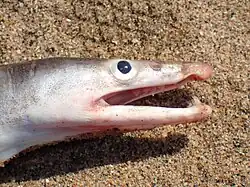Common pike conger
| Common pike conger | |
|---|---|

| |
| Detail of head | |
| Scientific classification | |
| Kingdom: | Animalia |
| Phylum: | Chordata |
| Class: | Actinopterygii |
| Order: | Anguilliformes |
| Family: | Muraenesocidae |
| Genus: | Muraenesox |
| Species: | M. bagio
|
| Binomial name | |
| Muraenesox bagio (F. Hamilton, 1822)
| |
| Synonyms | |
|
Muraena bagio | |
| Nutritional value per 100 g (3.5 oz) | |||||
|---|---|---|---|---|---|
| Energy | 288 kcal (1,200 kJ) | ||||
0 g | |||||
5.3 g | |||||
| Polyunsaturated | ~0.5 g | ||||
22.3 g | |||||
| |||||
| †Percentages estimated using US recommendations for adults,[2] except for potassium, which is estimated based on expert recommendation from the National Academies[3] Source: https://slism.com/calorie/110231/ | |||||
The common pike conger or pike eel (Muraenesox bagio) is a species of eel found throughout most of the Indo-Pacific.[4] In Australia, it is known in the southwest, in Western Australia, around the tropical north of the country, and south to the coast of New South Wales.[5] The common pike conger grows up to 2 m (6 ft 7 in) in length and 7.1 kg (16 lb) in weight.[4] A nocturnal predator, the common pike conger lives in estuaries and near the shore to a depth of 100 m (330 ft).[4][5] A strong and muscular fish, the common pike conger is a delicacy in South East Asia and features in various dishes.[6]
Breeding
In Australia, the females lay the eggs off the coasts; the eggs take 9–10 weeks to hatch. A female can lay up to four million eggs in a single year.
Nutrition
Pike conger is a nutrient-dense seafood, rich in protein, omega-3 fatty acids, and vitamins A, D, and B12. It supports cardiovascular health, neural development, and bone strength. Its low mercury content makes it a safer choice for frequent consumption compared to predatory fish.
References
- ^ McCosker, J.; Smith, D.G. & Tighe, K. (2022). "Muraenesox bagio". IUCN Red List of Threatened Species. 2022: e.T199341A2585044. doi:10.2305/IUCN.UK.2022-2.RLTS.T199341A2585044.en. Retrieved 31 December 2023.
- ^ United States Food and Drug Administration (2024). "Daily Value on the Nutrition and Supplement Facts Labels". FDA. Archived from the original on 2024-03-27. Retrieved 2024-03-28.
- ^ "TABLE 4-7 Comparison of Potassium Adequate Intakes Established in This Report to Potassium Adequate Intakes Established in the 2005 DRI Report". p. 120. In: Stallings, Virginia A.; Harrison, Meghan; Oria, Maria, eds. (2019). "Potassium: Dietary Reference Intakes for Adequacy". Dietary Reference Intakes for Sodium and Potassium. pp. 101–124. doi:10.17226/25353. ISBN 978-0-309-48834-1. PMID 30844154. NCBI NBK545428.
- ^ a b c Froese, Rainer; Pauly, Daniel (eds.). "Muraenesox bagio". FishBase. September 2017 version.
- ^ a b "Common Pike Eel, Muraenesox bagio (Hamilton-Buchanan, 1822)".
- ^ "Giant sea creature found on Australian beach confuses locals". International Business Times. 16 February 2016.
